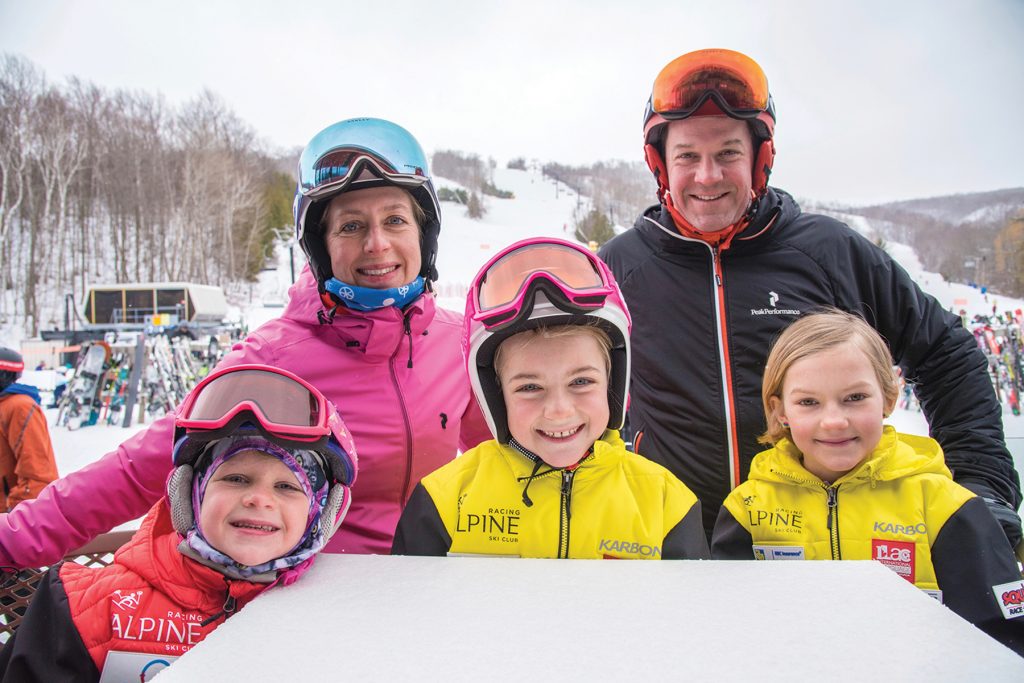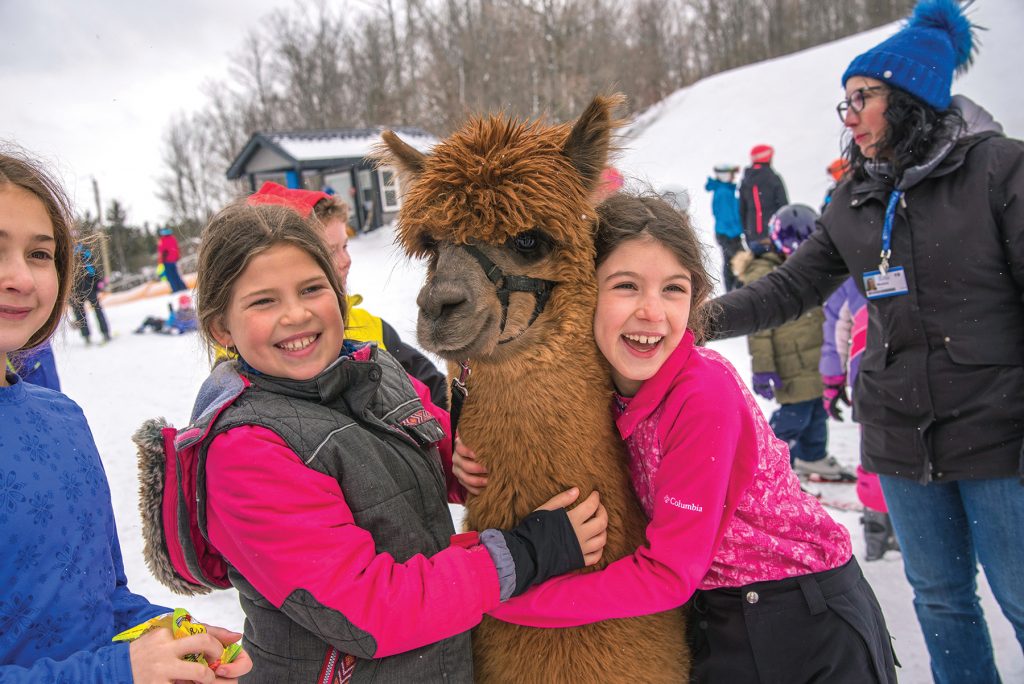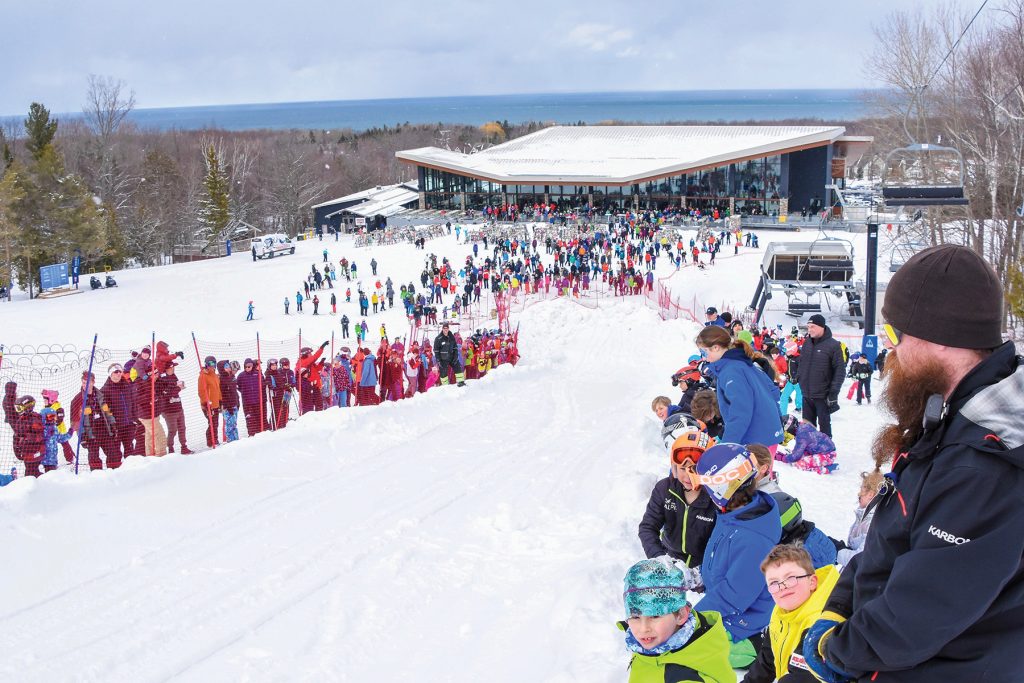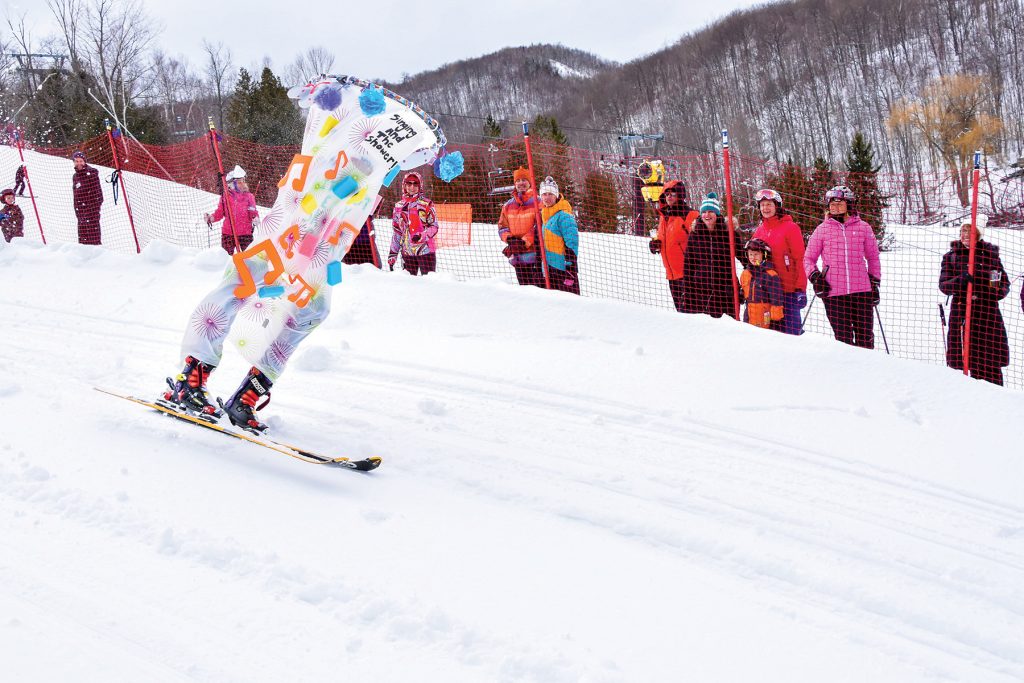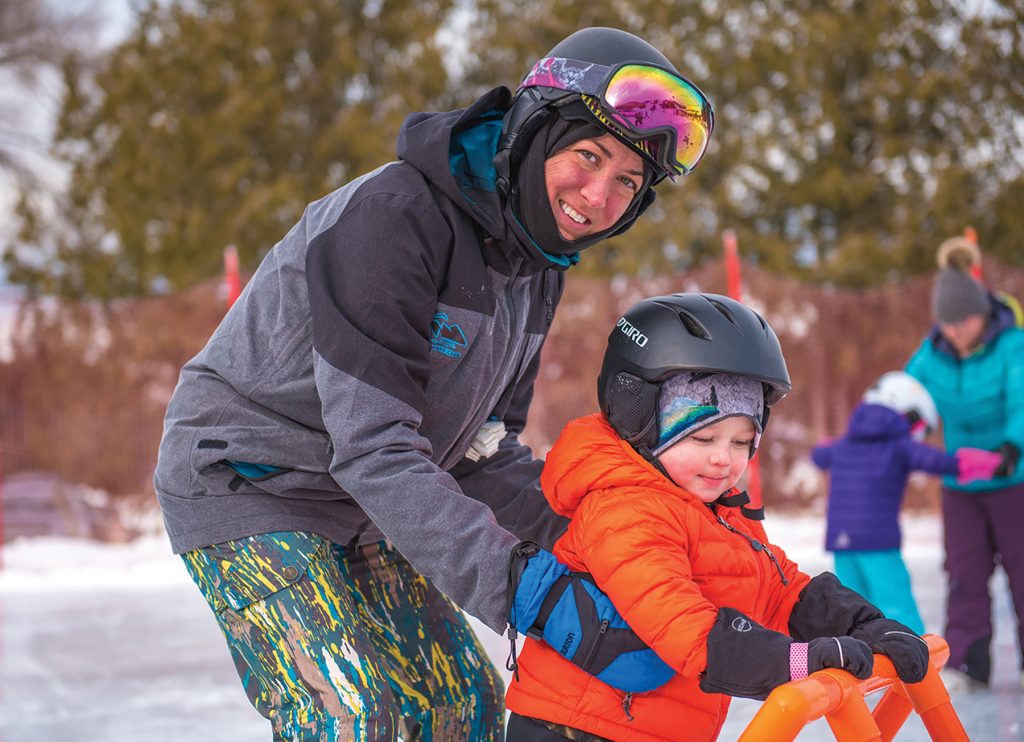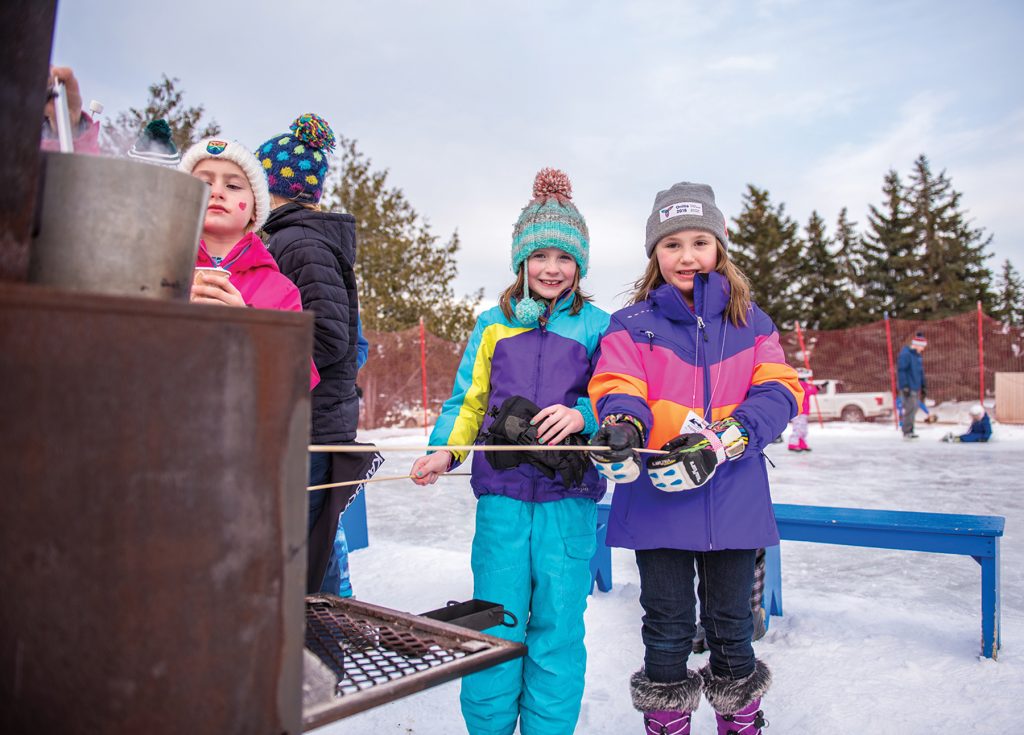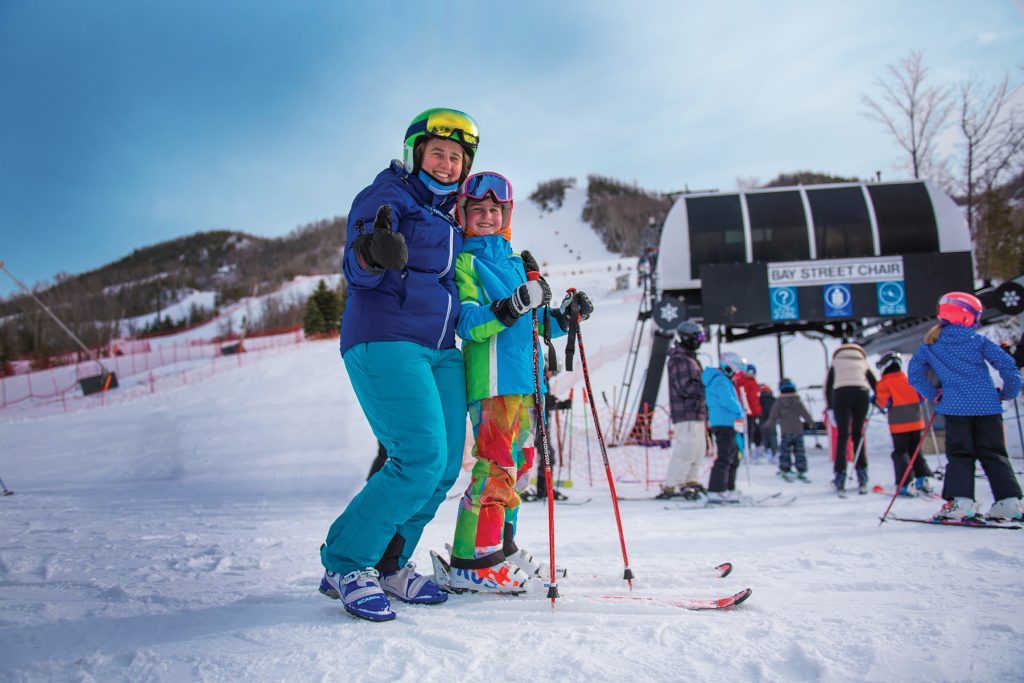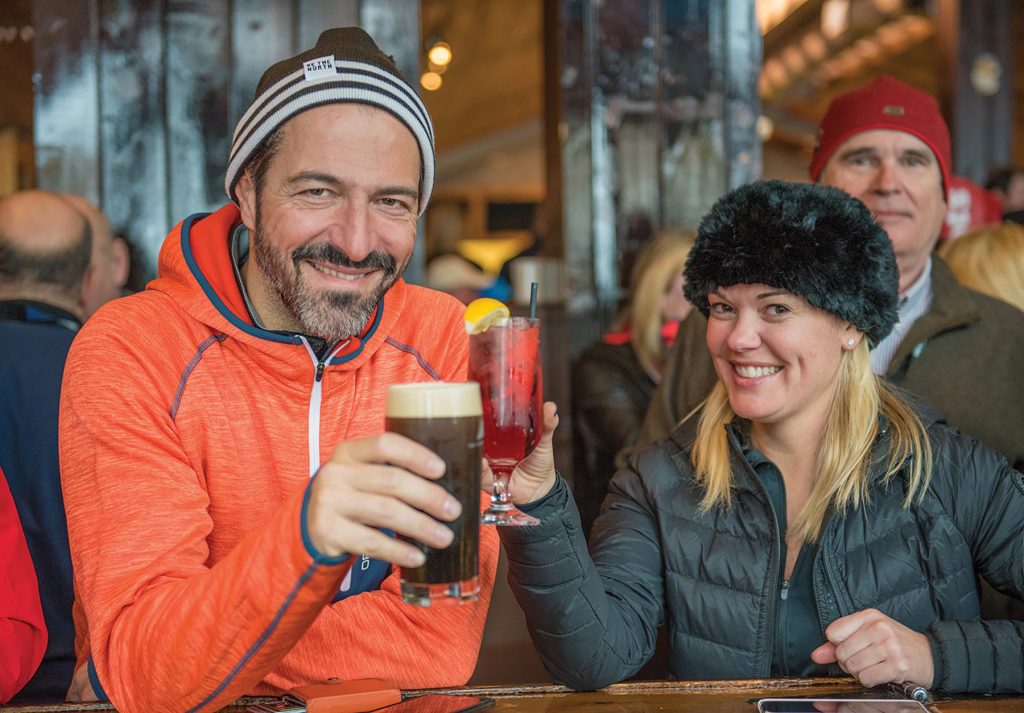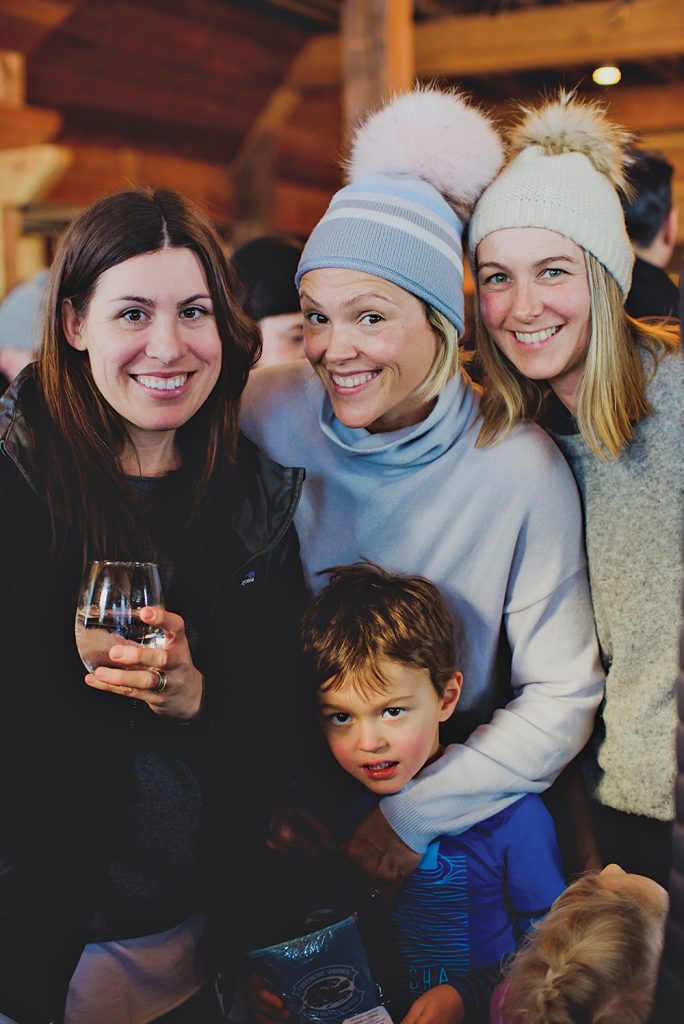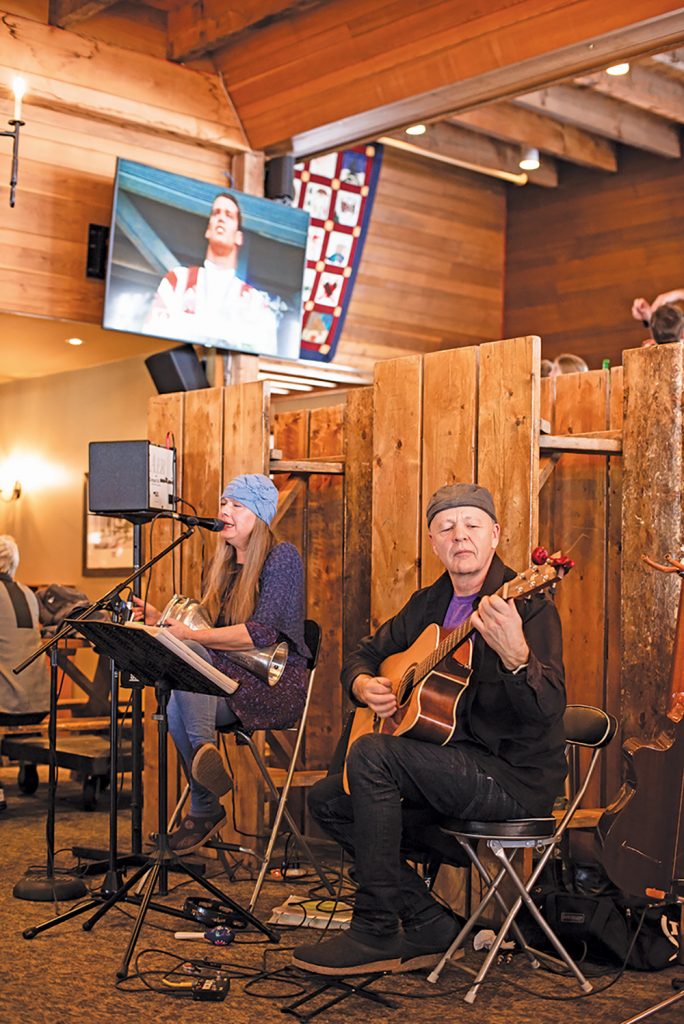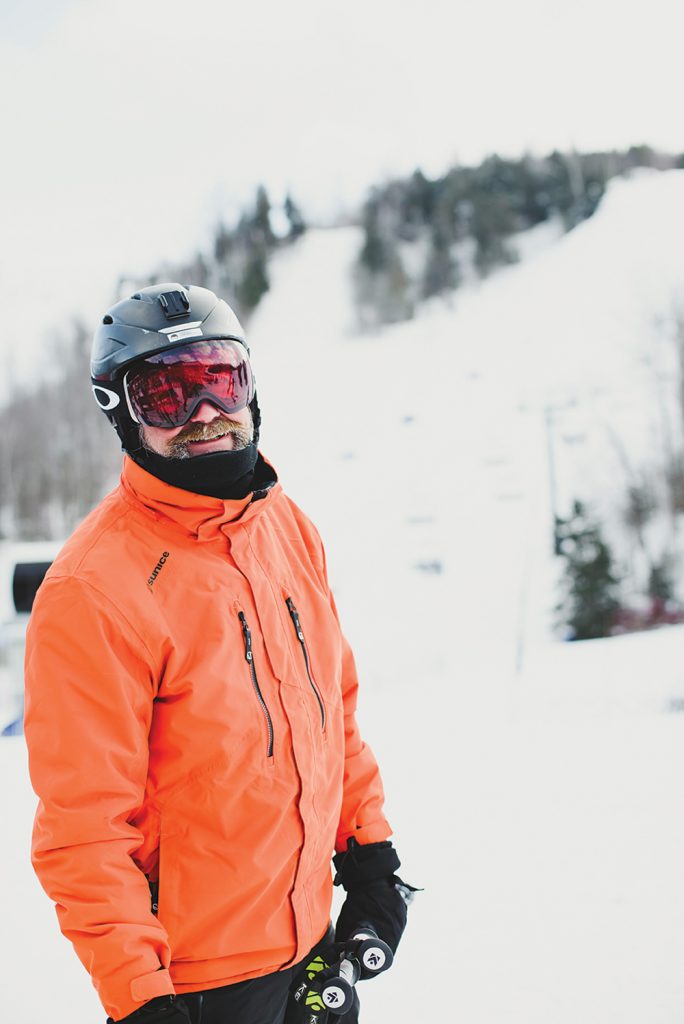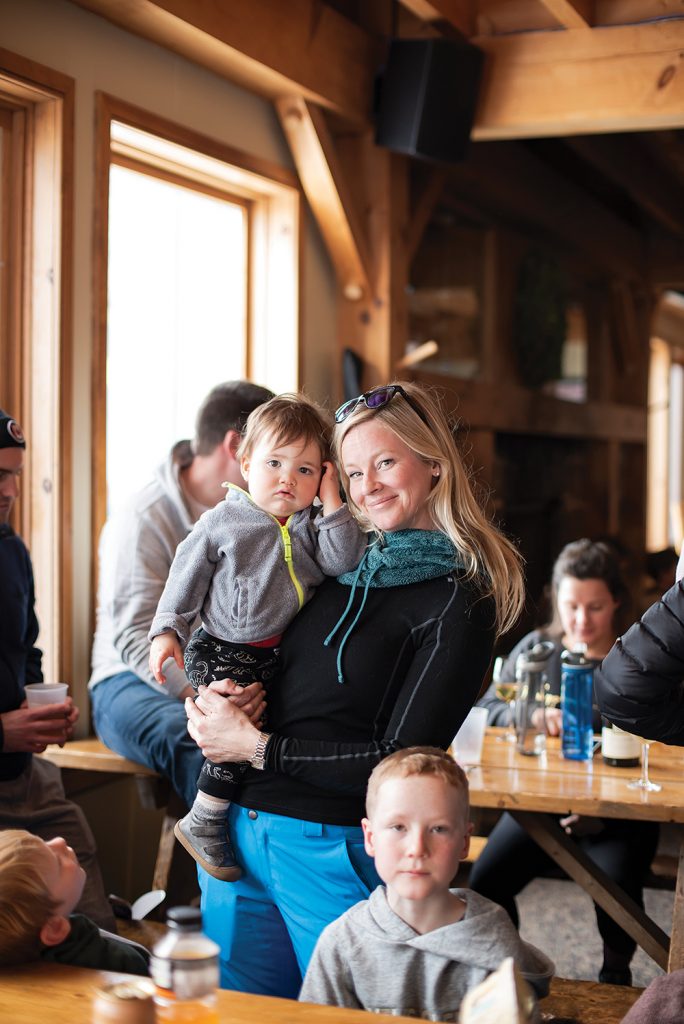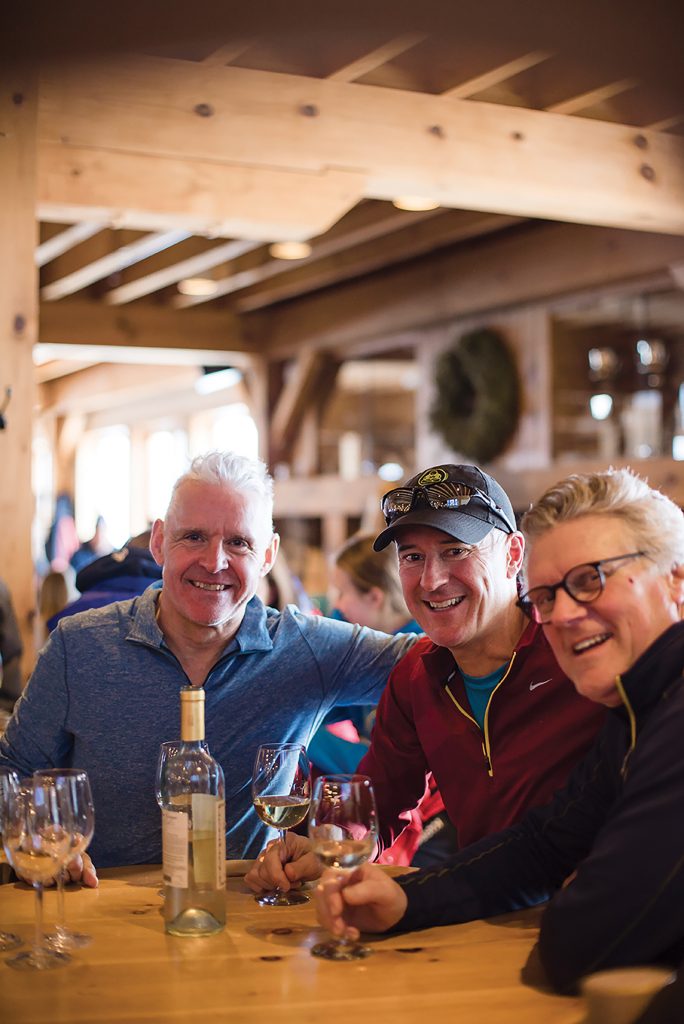Our local ski clubs provide plenty of opportunities to socialize, make friends, enjoy family time and have fun
by Laurie Stephens
photography by Doug Burlock & Jessica Crandlemire
No sooner does the first snowflake hit the ground than I am salivating about the start of ski season, looking forward to squeezing feet into boots, clipping into bindings, skating over to the lift and chatting with the friendly staff and members at Alpine Ski Club, who come back every year because they, like me, have winter sports in their blood.
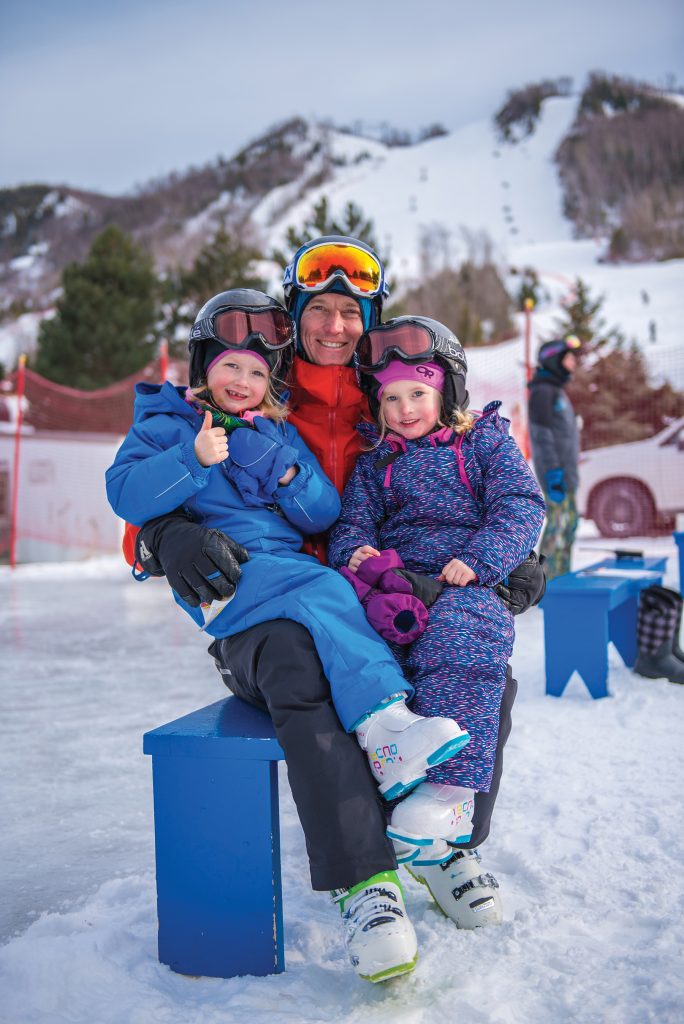
Alpine has been like a second home for my family ever since we first started skiing at the private club in 1981. My children – now adults – literally grew up on the hill, one on skis at the age of three, the other even younger. When they weren’t skiing or boarding down the pitches, they were playing on the side of a hill or building snow forts and slides with other kids. Meanwhile, the adults could ski off on our own, knowing full well that our children were being watched over by staff and friends.
Alpine Ski Club is our winter social network. We spend most of our time on the slopes, playing with like-minded friends who ski in all kinds of conditions but live especially for the perfect winter ski day: bright sun, crisp temperatures and new-fallen snow. Afterwards, physically spent from a day of exercise and fresh air, we indulge in après ski at the club, cracking open a beverage or two, snacking on hors d’oeuvres and comparing notes about the day.
It’s a way of life we’ve embraced for almost 40 years, and our lives are that much richer for it.
This experience of family togetherness and social interaction is not unique to Alpine. There are eight private ski clubs in the Southern Georgian Bay area, and each prides itself on providing members with unique opportunities for families and friends to gather and enjoy the long winter months.
“I think there’s a mutual respect amongst members, because they’re all here for the same reasons: build memories, build history, have fun, help the kids grow, and, for the moms and dads, blow off a little steam and do something maybe they haven’t done before, like ski racing,” says Bill Williams, now in his 35th year as general manager. “Plus catch up with the family on weekends, because they’re like ships in the night all week long.”
“I think there’s a mutual respect amongst members, because they’re all here for the same reasons: build memories, build history, have fun, help the kids grow, and, for the moms and dads, blow off a little steam.”
Bill Williams, Alpine Ski Club
Private ski clubs have a long tradition in Southern Georgian Bay, dating back to the early 1930s when the Blue Mountain Ski Club (BMSC) – now called the Collingwood Ski Club – was formed.
“We had a pioneer role in the development of skiing on Blue Mountain in the 1930s,” says club president Bill Brennan. “The very first people who skied at Blue Mountain during the ’30s were a group of local ski enthusiasts who discovered the snowy hills on the farms up the Blue Mountain slopes.”
The locals, many of whom worked at the Collingwood Shipyards, rented or purchased farmland on the side of Blue Mountain and cut ski runs into terrain that couldn’t be farmed because it was too steep.
In 1940, the BMSC joined with the travelling Toronto Ski Club – formed in 1924 – as an incorporated club (still called Blue Mountain Ski Club) that owned most of the skiable lands at Blue Mountain. While the two clubs together owned the land and facilities, they remained separate entities.
In 1941, the club gave six acres to Jozo Weider on his promise to build the Blue Mountain Lodge, and in 1946, BMSC agreed to a 999-year lease of its lands to Weider’s newly formed Blue Mountain Ski Resort. In the early ’60s, at Weider’s request, the club changed its name to the Collingwood Ski Club (CSC).
The CSC exists today as the smallest private club in the area, with its clubhouse, established in 1935, at the base of the north end of Blue Mountain Resort. The Toronto Ski Club’s lodge is located nearby, and both use Blue Mountain Resort as their base for member skiing.
Since those early days, six other private clubs have established a presence on the Niagara Escarpment, each with its own lodge and lifts on land the club owns, and each providing unique environments for their members – from rustic to toney, intimate to expansive, edgy to sedate.
Osler Bluff Ski Club was the first private ski resort created on the Niagara Escarpment west of Collingwood in 1949, followed by Craigleith Ski Club in 1958, and Alpine Ski Club and the Georgian Peaks Club in 1960. All four of these clubs offer 700 or more vertical feet of groomed runs that face Georgian Bay.
Two smaller clubs, Devil’s Glen Country Club in Duntroon and Beaver Valley Ski Club in Markdale, were established in 1962 and 1967 respectively, and both feature more than 500 vertical feet of trails in more secluded settings.
While the features of the clubs differ widely, so does the price to purchase a membership. Of the clubs with their own ski hills, Osler Bluff has historically been the most expensive to join, with an initiation fee of $57,500 for a family membership today. Craigleith is $43,000, Alpine $39,500, Devil’s Glen $38,500, Georgian Peaks $35,000 and Beaver Valley $18,000.
The Toronto Ski Club and Collingwood Ski Club, whose members have access to Blue Mountain through a discounted Resort IKON ski pass, do not have to maintain the skiing infrastructure at a club and therefore can charge much less to join. Families at TSC can become members for $8,000, while Collingwood Ski Club’s family initiation fee is $350 (TSC’s fee is higher because it has paid staff and runs programs for its members, while CSC is managed by volunteers and does not provide programs).
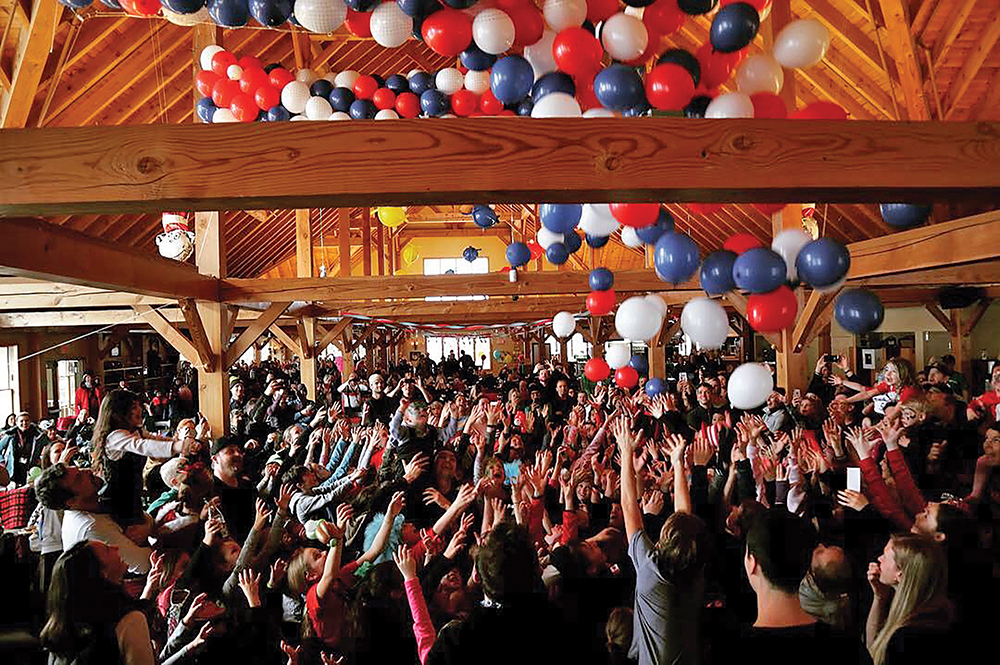
Clubs also charge their members annual dues on top of the initiation fee, and these can range from just under $200 for seniors, students or children to about $2,000 for adults.

Given such a potentially significant outlay, it’s a fair question to ask why people join private clubs. There are many different reasons why people do so, from family time to racing programs to social and business networking, but certainly, the quality of the experience is a key draw. After all, each member – as a shareholder in a club – makes a significant investment and has high expectations for the services and facilities that provide the benefits of membership.
“The private ski club experience is as much about family and safety and community as it is about the actual skiing and snowboarding,” says Tim Oliver, general manager of Beaver Valley. “At a private ski club, the expectations of what the on-hill product is, is extremely high in comparison to your average public setting. And the expectation in terms of the social events and the family atmosphere is just as high. What I find is that people are willing to reach into their pocketbooks to ensure that their family is going to have the best experience on and off the hill.” Alpine’s Williams notes that public resorts are driven by revenue, while private clubs look for the “extra quality” they can bring to the member experience.
“A private club doesn’t need a six-pack chairlift; a private club does not need a 45,000-square-foot lodge for 2,000 skiers on a weekend day,” he says. “But they offer the experience of fewer people around, the detachables (high-speed chairlifts) get you up the hill faster and everything just flows a little easier with less stress because you’re not being skied over.”
The secret ingredient to attracting and retaining members is the rich, family-friendly social environment, a virtue that all private clubs extol. All clubs boast multi-generational memberships – Osler Bluff has a 99-year-old grandfather still actively skiing with his children and grandchildren – which means that private clubs have to invest in providing activities for all ages, on and off the hill.
As a result, all clubs have myriad offerings beyond just the downhill experience. From snowshoeing, tobogganing and skating to annual events like Robbie Burns Day and men’s and ladies’ days, to après activities that feature live music, wine, scotch and craft beer tastings, plus a variety of family events and activities, our private clubs offer something for everyone, all season long.
The social connections with family and friends cultivated by these activities are a key reason why people consider joining private clubs.
Katherine Gyles joined the Toronto Ski Club in 2006 when her children were young as a winter weekend family activity in which everyone could participate and enjoy equally.

“The private ski club experience is as much about family and safety and community as it is about the actual skiing and snowboarding. At a private club, the expectation is extremely high in comparison to your average public setting.”
Tim Oliver, Beaver Valley Ski Club
“We love being outside and we love being active and we’re social people, so we thought joining a ski club made sense for us,” she notes. “We already had friends who were there. My husband had previously been a member and his best friend was and continues to be there, and that demonstrated to us the foundation of long-standing friendships and also a really nice family environment.”
For other private club members, including my family, the social factor also delivers safety. When my children were young, we felt comfortable leaving them to ski on their own at Alpine because we knew employees and other members were looking out for them. It’s a common benefit across all private clubs.
“At a private ski club, there are way fewer skiers and boarders on the hill and everyone’s looking out for everyone else a little bit, in a community, neighbourly kind of way, rather than, ‘Hey, this is my run, get out of my way,’” says Doug Wansbrough, general manager at Devil’s Glen.
All of our local clubs strive for a distinctive social flavour to set them apart from the competition.
Beaver Valley, one of the smaller clubs on the Escarpment, is known as arguably the friendliest private club and is unique compared to some of the others because it is removed from the Collingwood corridor. “We find that our largest signature item is that we are isolated a little bit, which ensures that when parents come up here with their kids, this is where they’re staying; they’re here for the weekend or the week, and it’s all about family time and not having to drive everywhere,” says Oliver.
One of Beaver Valley’s most popular social events is the Romp and Stomp, in which 200 to 300 members snowshoe out to a designated area, have a coffee or tea, loop back to the chalet, meet some people and then head off to the next destination. The event takes several hours to complete, and the club brings in bands for music and a big dance afterward.
“Basically, you know your exercise hasn’t gone to waste,” jokes Oliver, now in his fifth season as GM. “It’s a great big social event that doesn’t actually require skiing or snowboarding, but having it established on a private ski club makes it exponentially better.”
Alpine’s Festival Day marking the end of the season is always a huge draw for all ages and really epitomizes the club’s focus on the family experience, most recently featuring a petting zoo with four fuzzy alpacas as the star attraction for kids and adults alike.
The day culminates with the annual Downhill Dummy Race, where ski dummies constructed and decorated by members are sent down a short racecourse that ends with a jump. If a dummy successfully makes it down while being bombarded by snowballs from members lining the course, it must then try to make it over the jump. Speed is important, and the faster the dummy, the higher it flies over the jump, generating fits of laughter and applause from the crowd.
Once the last dummy has attempted its run, the race is done, and members head over to the deck for an après beverage while a DJ spins some music – a great way to end a day on the slopes.
All of the day’s activities take place in and around the club’s stunning new, 45,000-square-foot clubhouse that opened for the 2016-17 season. The space offers many places to congregate: the bar with its sweeping view of the hills is a particularly popular spot, while the huge stone deck is great vantage point for members to observe the petting zoo or cheer on the dummies racing down the course.
The new clubhouse has become the heart of Alpine’s social life, packed every Saturday afternoon – including in the summer, when it hosts weddings, celebrations of life, fundraisers and fashion shows. The importance of a state-of-the-art, year-round clubhouse is a point not lost on Osler, Craigleith or The Peaks – all three are in the process of building or renovating their own chalets to better accommodate members and events in winter and summer.
Williams says there’s a clear pride of ownership at Alpine: “It’s a family experience, and you’re there with your family building history, building a lodge, putting a chairlift in. That’s what it’s all about.”
The area’s most rustic and intimate private club is the Collingwood Ski Club, operating out of a small A-frame chalet at the north end of Blue Mountain Resort.
Its social appeal is rooted in its unique model: it is not only member-owned, it is also member-run. There are no paid positions, only volunteers. In addition, its members all have to come from the local community, from Meaford to Wasaga Beach and all points in between.
Members have seven-day access to Blue Mountain Resort, and it’s not uncommon for members at the other private clubs to also join the Collingwood Ski Club so they can ski at Blue Mountain early in the week when their club is not open.
Collingwood Ski Club is very family oriented, says Brennan, who’s been at the CSC for 10 years and is a former member of Alpine. One of its more popular social events is its Sunday lunches, prepared by a member family or two for the other members, with all food and beverages paid for by the club. “Every member picks up the slack. The members have the free use of all kitchen facilities in the chalet. There are two barbecues on the deck and anyone can use them,” notes Brennan.
Craigleith is the largest private club on the Escarpment, known for its wide, sweeping runs and its state-of-the-art snowmaking, which enables the club to open as many runs as possible at the start of the ski season. It is currently spending $18 million to build a multi-function centre and expand the base lodge for the start of the 2020-21 season.
Longtime members like David Rose, who’s in his sixth decade skiing at Craigleith, recall unique social experiences that defined the early days of skiing, like gathering at the club for “rock-picking” parties in the fall.
“We’d just climb up the hill and dig the rocks up and throw them off into the woods so you didn’t rip your bases off – there was no grooming then,” Rose says. “In the ’60s and ’70s, members did a lot more work, planting trees, taking rocks off the hills and stuff like that.”
Needless to say, the club’s social offerings have grown since then. Skinanigans, Craigleith’s spring carnival, is a family event that features costume parades, scavenger hunts, face-painting and toboggan rides by the ski patrol. For adults, the Wine Festival is a hugely popular event that’s held in January each year, says Jeff Courtemanche, Craigleith’s general manager for more than 30 years. “Groups of friends have tables and will have wines from different countries, so adults can go and sample them and enjoy camaraderie and friendship amongst the membership.”
The club also has three different New Year’s Eve events that cater to all age groups, an après-ski every Saturday that often features local musicians, fitness boot camps, magic workshops, puddle jumps, and ‘mommy and me’ yoga.
“The club is a hub of activity and a great family experience for all generations,” says Courtemanche.
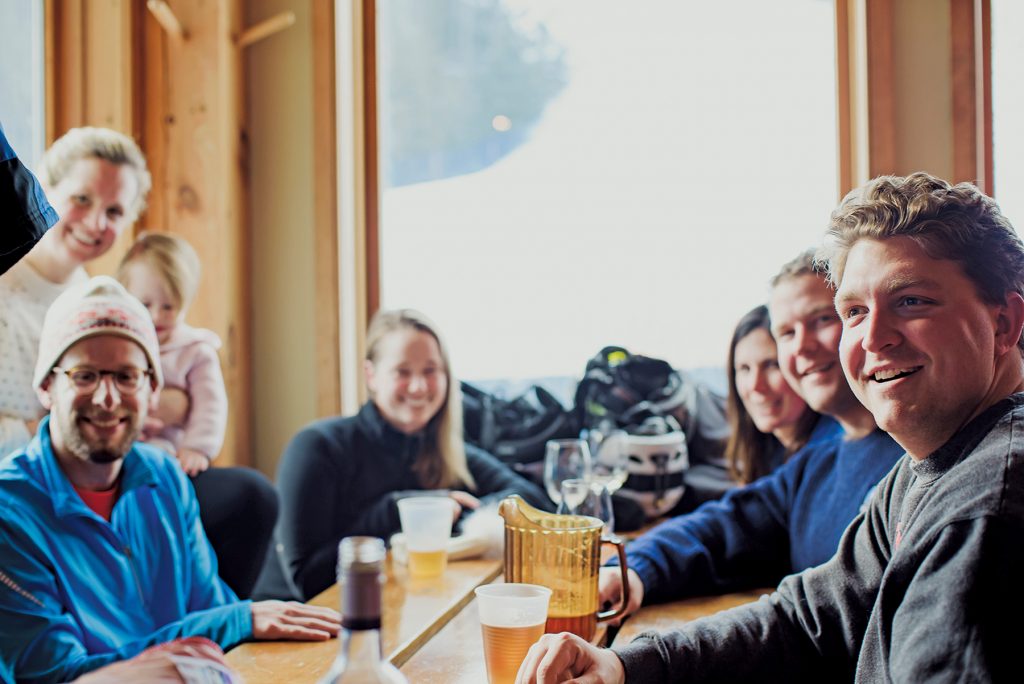
Devil’s Glen is one of the private clubs that uses its smaller size to promote a more intimate experience. “It’s what everyone talks about Devil’s Glen,” says Wansbrough, now in his 14th season as general manager. “Because we’re smaller, members get to know each other, and that creates a strong sense of community that Devil’s Glen is known for.”
The club plans social activities with a view to helping people interact with members they may not have met yet. Beerfest is a good example, where the club invites local craft breweries to set up tasting stations inside the clubhouse. It’s a popular event where members mix and mingle and “maybe bond over a local brew – like a Creemore Lot 9 or whatever – and they’re able to strike up that new friendship.”
For Sandra Gee, a longtime member at Devil’s Glen, it’s all about family. Her uncle was a founder of the club in 1965, her father one of the first directors, and she and her sister Nancy raced on the steep pitches at the club, with Nancy going on to compete in the 1988 Calgary Olympics.
“My dad used to always say that his favourite time of the year was a Friday in the wintertime,” she says. “He got to put Nancy and I and mom in a car for two-and-a-half hours and it was a time to talk and sort of reflect on your week, get all caught up. Even though we had fun up here and we sort of disappeared to go out and toboggan or whatever, he knew that we were together in place for the whole weekend. He used to say, ‘the family that skis together stays together.’ ”
Georgian Peaks members take pride in the club’s status as being somewhat ‘edgy’ – a quality on full display at its year-end party called the Lively Cup, an adults-only evening event where everyone is happy to let their hair down, says Nick Hamilton, a member since 2006.
“It’s insane; completely unhinged,” he says. “It might be a little extreme for some and this comes back to what the culture at the Peaks is all about. It’s a little bit more extreme and unrefined, and that means that when we want to have fun, we have fun, when we want to ski fast, we ski fast, and just explore the extremes that way, in a sensible way, not a reckless way.”
Family Day in February is also a big draw, featuring a skating rink specially constructed for the weekend, a bonfire with hot chocolate and marshmallows, a fire dancer, magic acts and juggling.
“The kids really love it,” says general manager Chris Beckett. “We really try to focus in on the young kids because that brings the adults, and the little kids really have a good time while they’re here.”
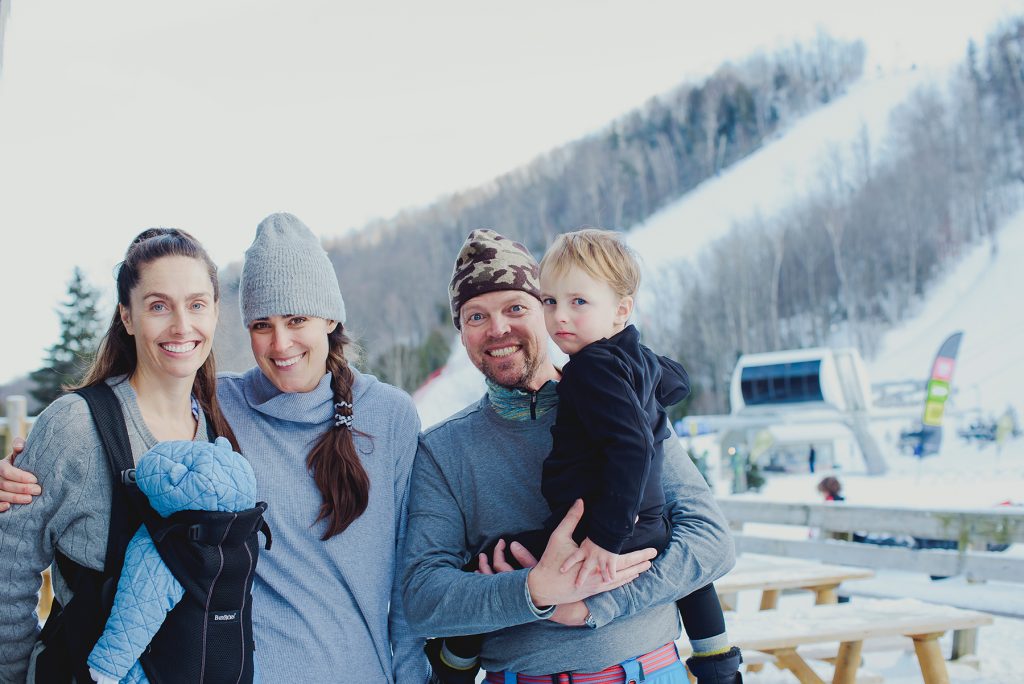
My dad used to always say that his favourite time of the year was a Friday in the wintertime. He knew that we were together in place for the whole weekend. He used to say, ‘the family that skis together, stays together.’
Sandra Gee, Devil’s Glen Member
Members at The Peaks are also excited about the prospect of a new 40,000-square-foot-clubhouse expected to be open in December 2020. With members literally rubbing elbows in the existing space-challenged lodge, Beckett says the new space, with a very large deck facing the hill, will better accommodate the club’s popular après-ski activities.
“Right now, we have more crowding at our bar and on our deck than we do at our lifts.”
Osler Bluff is also excited to be opening its newly expanded and fully renovated main chalet this season – a 30,000-square-foot space that offers better flow and more elbow room for members. A new bar that is double the size of the old one will be a popular gathering place because of its prime location in the centre of the lodge near large windows that look out onto the ski hill, says Jeff Conn, who worked his way up to general manager after starting as a parking lot attendant at the club 40 years ago this year.
The new lodge will be a better site for the club’s social events, including the annual Candlelight Dinner, a big costume party in February where groups of members go all out dressing up in theme – like Gilligan’s Island or Pirates of the Caribbean – and decorating their tables.
Another unique event is the annual Arty Party, where members with artistic talents bring their art to the club. Osler provides special lighting and easels to display paintings, jewelry, ceramics and woodworking, some of which is for sale. “It just really blows my mind when you walk over to the Arty Party and go ‘Wow, I didn’t realize we had so many members with so much talent,’ ” says Conn.
For members of the Toronto Ski Club, there is the common attraction of carving runs on exceptional terrain while still feeling like they belong to a small, family-oriented club. Even though the club lacks its own dedicated hill, members are a tight-knit group – again, multi-generational – who enjoy seven-day access to Blue Mountain Resort and are fiercely proud of the club’s history.
Graydon Oldfield, chair of the board, says the club’s mission is to create snowsports enthusiasts for life, and he’s proof of that. His parents became members in 1968 and he’s been a member since his birth in 1973, eventually becoming involved in the club’s storied racing program and competing at the World Cup level in the mid 1990s.
“I’ve been a part of the fabric of this club for a long, long time, so it’s kind of ingrained in my blood from a family perspective first and then from a (racing) program perspective second.”
The Toronto Ski Club is also known for its legendary après-ski activities. “I think the club does après really well,” says Gyles. “There’s Oysters and Martinis Day, there are bands that come back every year that people enjoy. It’s an opportunity after you get off the ski hill to have a bit of social before you leave and continue to enjoy the rest of the evening with your family.”
While each club promotes its own social flavour, it’s clear that time with family is the core attraction for belonging to a private club.
“That’s what skiing and snowboarding give us – an opportunity for multiple generations to participate.”
Doug Wansbrough, Devil’s Glen
“People love to be able to do things with their family and if they’re not participating, they’re generally watching someone else do it,” says Wansbrough. “That’s what skiing and snowboarding give us – an opportunity for multiple generations to participate.”
Being part of a shared community and gathering together after a morning or a day on the slopes provides meaningful connection these days when everyone’s lives are so busy. Belonging to a private ski club gives families like mine a reason to congregate and enjoy each other’s company, while building lifelong friendships and creating lasting memories of our long Canadian winters.
Let the ski season begin. ❧






